Highlights: Analyzing the application needs and business models of cloud-edge collaboration in typical scenarios with a rational and optimistic attitude.
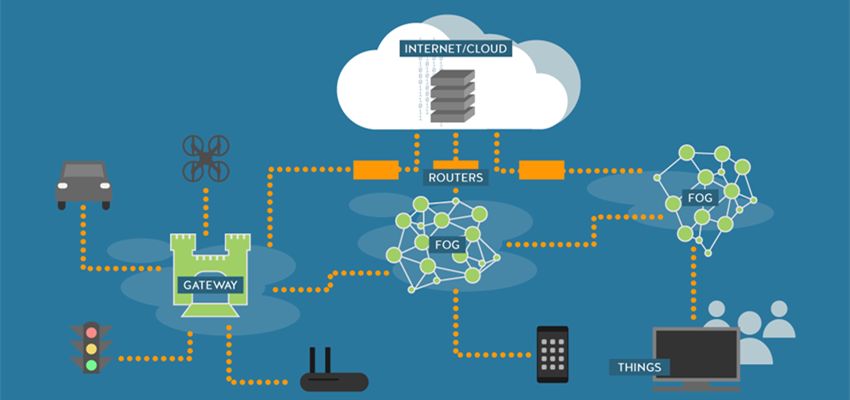
In 2019, edge computing attracted significant attention from the industry, leading to an investment boom in the capital market, with many referring to 2019 as the inaugural year of edge computing. Rationally speaking, the explosive situation inevitably has some hype factors at play, as the concept of edge computing has existed for many years. However, it is undeniable that the strong promotion of the industrial internet and the ongoing preparation for the large-scale commercial use of 5G have instilled confidence and anticipation in the deep integration of IT and OT within the entire industry. Under such circumstances, it may be difficult for edge computing not to thrive.
In this issue of Smart Insights, we recommend a report from the Cloud Computing Open Source Industry Alliance, which analyzes the application needs and business models of cloud-edge collaboration in typical scenarios with a rational and optimistic attitude, laying the groundwork for guiding industry development and formulating relevant standards. If you want to save a copy of this report (Nine Application Scenarios of Cloud Computing and Edge Computing Collaboration), you can reply with the keyword “nc383” on Smart Insights (WeChat public account: zhidxcom) to obtain it.

The New Wave of Cloud-Edge Collaboration
1. Edge Computing as a New Extension of Cloud Computing
The European Telecommunications Standards Institute believes that edge computing provides IT service environments and computing capabilities at the edge of mobile networks, emphasizing proximity to mobile users to reduce latency in network operations and service delivery, thereby enhancing user experience.
Gartner defines edge computing as a computational topology where information processing, content collection, and distribution occur closer to the source of information.
Wikipedia describes edge computing as a method for optimizing cloud computing systems by performing data processing at the network edge, close to the source of data.
The Edge Computing Industry Alliance defines edge computing as an open platform that integrates network, computing, storage, and application core capabilities at the network edge, close to the source of the object or data, providing edge intelligence services to meet key demands in industry digitization such as agile connectivity, real-time operations, data optimization, application intelligence, and security and privacy protection.
The Open Fog Consortium views fog computing as a horizontal system-level architecture that brings computing, storage, control, and network functions closer to users within the cloud-to-object continuum.
Although the various definitions of edge computing differ in expression, they fundamentally convey a consensus: providing services at the network edge closer to the endpoint.
The “Center-Edge-End” model has been established since the inception of telecommunications. In the telecommunications era, the programmable switching center, programmable switches, and telephones formed the initial “Center-Edge-End” model; in the internet era, data centers, CDN, mobile phones/PCs continued this model; as we reach the era of cloud computing + IoT, cloud computing centers, small data centers/gateways, and sensors form a new “Cloud-Edge-End” model.
 ▲ Diagram of the “Cloud-Edge-End” Development
▲ Diagram of the “Cloud-Edge-End” Development
It seems difficult to fully accept this somewhat all-encompassing new thing if we only seek the definition of edge computing from the edge itself. A straightforward question is whether smart terminals, home gateways, or other computing devices that have existed around us for years have hidden their edge computing identities.
To praise edge computing, some voices have described the concept of cloud computing as somewhat narrow or deliberately positioned it in opposition to edge computing. However, from the perspective of technological or commercial evolution, edge computing is more of a new solution formed by extending cloud computing to the endpoint and user side. Edge computing is an extension of the cloud computing concept; even if it is given an independent concept, it cannot be completely severed from cloud computing, as both are interdependent and operate in synergy.
In this white paper, we believe that in scenarios involving IoT, large traffic, etc., to meet the demands for broader connectivity, lower latency, and better control, cloud computing is advancing towards a more globalized distributed node combination, and edge computing is its new extension to the edge side.
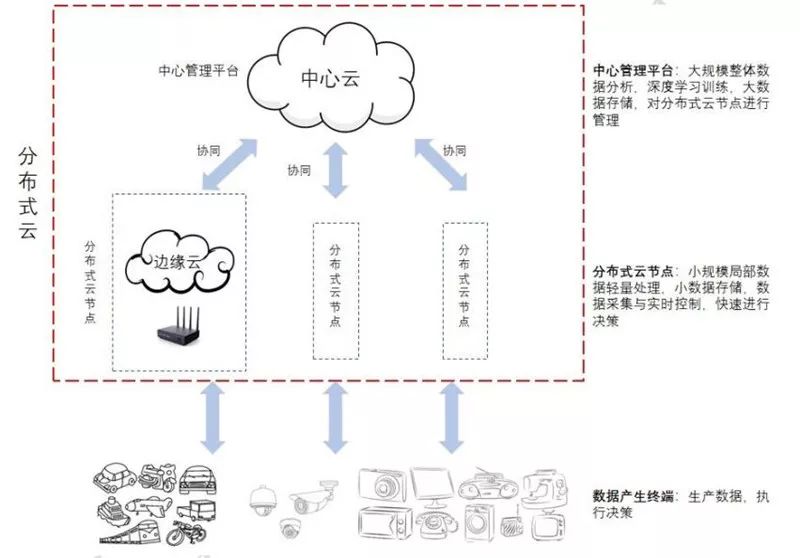 ▲ Distributed Cloud Diagram
▲ Distributed Cloud Diagram
2. Typical Products and Business Models of Edge Computing
Major companies dominating the cloud computing market leverage their first-mover advantage in cloud computing technology to extend cloud computing technology to the edge side, using the opportunity to strengthen edge-side artificial intelligence to vigorously develop edge computing. Industrial enterprises rely on rich industrial scenarios to strengthen field-level control through edge computing practices. Telecom operators are seizing the opportunities of the 5G market, comprehensively deploying edge nodes to lay a solid foundation for the next-generation infrastructure.
ICT service providers are gradually expanding cloud computing capabilities to edge devices. Internationally, cloud computing giants like Amazon, Microsoft, and Google have already launched related edge computing products. Amazon has introduced AWS Greengrass, which extends AWS to devices, processing data generated at the terminal locally while still utilizing the cloud for management, data analysis, and persistent storage; Microsoft released the Azure IoT Edge product, extending cloud analytics to edge devices, supporting offline use while focusing on edge artificial intelligence applications; Google also launched the hardware chip Edge TPU and software stack Cloud IoT Edge in 2018, which extends data processing and machine learning capabilities to edge devices, enabling real-time operations on data from its sensors and local result predictions.
In China, Alibaba, Tencent, Baidu, Huawei, ZTE, Shumeng Technology, and H3C have also launched corresponding edge computing products.
Alibaba launched the Link IoT Edge platform, deploying it across various scales of smart devices and edge computing nodes. By defining object models to connect devices with different protocols and data formats, it provides secure, reliable, low-latency, low-cost, and easily scalable local computing services; Tencent launched CDN Edge for edge computing, sinking the services of data centers to CDN edge nodes, responding to terminal users with the lowest latency while reducing the computing pressure and network load of the user data center.
Baidu launched the Intelligent Edge BIE, extending cloud computing capabilities to user sites, providing temporary offline and low-latency computing services, while working with the Intelligent Edge Cloud Management Suite to form an integrated solution of “cloud management, edge computing”.
Huawei launched the IEF platform in 2018, providing the ability to extend cloud applications to the edge by managing users’ edge nodes, linking data from edge and cloud for a complete integrated service solution of edge computing.
ZTE launched edge computing products that provide a full set of infrastructure from hardware to software, supporting various system-level edge computing solutions, offering high-performance applications on edge computing platforms; Shumeng Technology launched a unified DT resource management product, providing integrated management capabilities of “two domains + three forms”, covering central node domains, edge node domains, and three forms of unified management for cloud platforms, data centers, and business centers.
H3C launched a hyper-converged edge computing product UIS-Edge, supporting various hardware forms and deployment methods, extending cloud-native capabilities to the edge, providing comprehensive device access, edge computing, and cloud-edge collaboration capabilities, offering one-stop cloud-edge-end integration solutions for enterprises.
Industrial enterprises leverage rich industrial scenarios to enhance on-site application capabilities. Haier has developed a one-stop device management platform COSMOEdge specifically for IoT enterprises, providing multi-source edge device access capabilities and powerful edge computing capabilities, supporting the parsing of various industrial protocols, offering visual streaming pipelines, digital modeling, and physical mapping, providing device-as-a-service application models to help users quickly build IoT applications and achieve digital production, thus enhancing enterprise efficiency; RootCloud provides an open IoT platform, offering IoT gateways, RootCloud T-Box vehicle-mounted IoT boxes, RootCloud connectors, and RootCloud IoT proxy open platforms, covering mainstream industrial controllers and protocol parsing to achieve one-stop quick access for various devices across industries, providing convenient, cost-effective, and open device access solutions.
Telecom operators comprehensively deploy MEC leveraging 5G. Mobile Edge Computing (MEC) utilizes wireless access networks to provide the IT services and cloud computing functionalities needed by telecom users nearby, achieving elastic utilization of computing and storage resources. Multi-Access Edge Computing (MAEC) further extends edge computing from telecom cellular networks to other wireless access networks.
3. How Cloud Computing and Edge Computing Collaborate
For example, in IoT scenarios, devices in the IoT generate a large amount of data that is uploaded to the cloud for processing, which can put significant pressure on the cloud. To alleviate the pressure on the central cloud node, edge computing nodes can handle data computation and storage within their scope. At the same time, most data is not one-time data; those processed data still need to be aggregated from the edge nodes to the central cloud, where cloud computing performs big data analysis, data mining, and algorithm model training and upgrades, pushing the upgraded algorithms to the front end, allowing front-end devices to update and upgrade, completing the self-learning loop. Additionally, these data also need to be backed up; in case of unexpected situations during the edge computing process, the data stored in the cloud will not be lost.
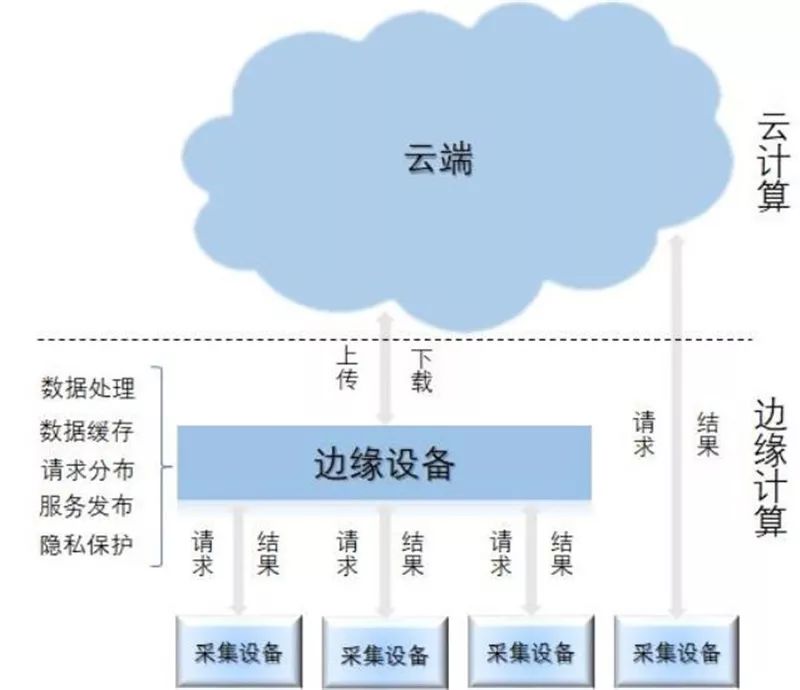 ▲ Diagram of Cloud-Edge Collaboration in IoT Scenarios
▲ Diagram of Cloud-Edge Collaboration in IoT Scenarios
Cloud computing and edge computing need to closely collaborate to better meet the matching of various demand scenarios, thereby maximizing the application value of both. Additionally, based on the characteristics of edge computing, real-time or faster data processing and analysis, saving network traffic, offline operation with support for breakpoint continuation, and higher local data security protection are all fully reflected in the various scenarios of applying cloud-edge collaboration.

Nine Application Scenarios of Cloud-Edge Collaboration
This white paper will introduce the applications of cloud-edge collaboration in scenarios such as CDN, industrial internet, energy, smart home, smart transportation, security monitoring, and agricultural production, while also analyzing the prospects of cloud-edge collaboration in healthcare, cloud gaming, and other scenarios.
1. Application of Cloud-Edge Collaboration in CDN Scenarios
With the current deployment of 5G, combined with AI technology, big data, cloud computing, IoT, etc., the information age of interconnected devices will usher the internet into a new phase. The current CDN architecture can no longer meet the application demands of the 5G era, and CDN will welcome a new development with edge cloud + AI, quickly responding to demands and achieving greater transparency in service capabilities, service status, and service quality. By deploying CDN within the mobile network, such as sinking virtual CDN (vCDN) into the operator’s edge data center through the edge cloud platform, it will significantly alleviate the pressure on traditional networks and enhance the experience of mobile users for video services. Building CDN based on cloud-edge collaboration not only expands the CDN resource pool based on the central IDC but also effectively utilizes edge cloud to further enhance the resource elasticity of CDN nodes.
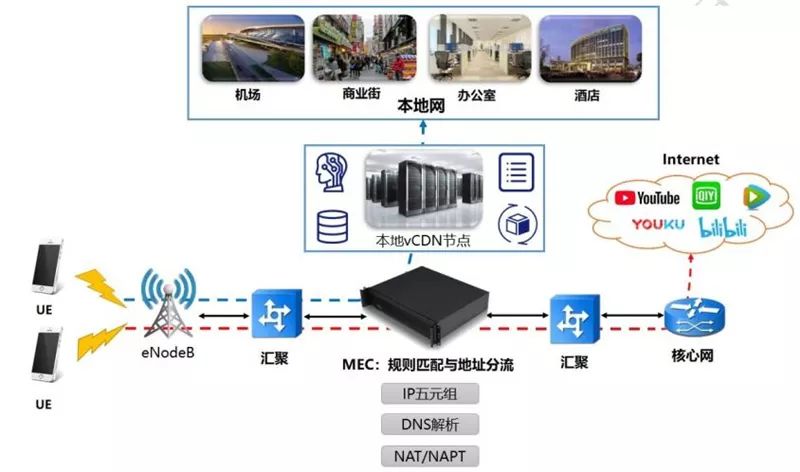 ▲ Implementation Scenario of vCDN Based on Edge Cloud
▲ Implementation Scenario of vCDN Based on Edge Cloud
CDN cloud-edge collaboration is suitable for localized + frequently requested hot content scenarios, applicable to supermarkets, residential areas, office buildings, campuses, etc. For recent hot videos and content, frequent local requests may occur. After establishing a vCDN node locally by once sourcing remote content, multiple requests for hot content within the locality can be distributed from the local node, improving hit rates and reducing response latency, thus enhancing QoS metrics. Similarly, this process can also be applied to 4K, 8K, AR/VR, 3D holographic scenarios, quickly establishing local scenes and environments, simultaneously improving user experience and reducing dizziness and latency.
2. Application of Cloud-Edge Collaboration in Industrial Internet Scenarios
In recent years, with government departments gradually introducing relevant supportive policies and the continuous improvement of ecological construction, the industrial internet industry in China is developing rapidly. According to IDC predictions, by 2020, more than 50% of IoT data worldwide will be processed at the edge, and the industrial internet, as an extension of IoT in the industrial manufacturing field, inherits the massive heterogeneous characteristics of IoT data. In industrial internet scenarios, edge devices can only process local data and cannot form a global understanding; thus, in practical applications, cloud computing platforms are still needed to achieve information integration, making cloud-edge collaboration an increasingly important pillar supporting the development of the industrial internet.
The edge computing and cloud computing collaboration in the industrial internet allows smart devices installed and connected in the edge computing environment to process critical task data and respond in real-time, rather than sending all data to the cloud and waiting for a response. The devices themselves act like mini data centers, with basic analysis performed on the devices, resulting in almost zero latency. With this new capability, data processing becomes decentralized, significantly reducing network traffic. The cloud can later collect this data for secondary evaluation, processing, and deep analysis.
At the same time, in the industrial manufacturing sector, single-point failures are absolutely unacceptable in industrial-grade application scenarios. Therefore, in addition to the unified control from the cloud, edge computing nodes on the industrial site must possess certain computing capabilities to autonomously judge and solve problems, timely detect anomalies, and better achieve predictive monitoring, enhancing factory operational efficiency while also preventing equipment failure issues. Processed data is uploaded to the cloud for storage, management, and situational awareness, while the cloud is also responsible for monitoring data transmission and managing the use of edge devices.
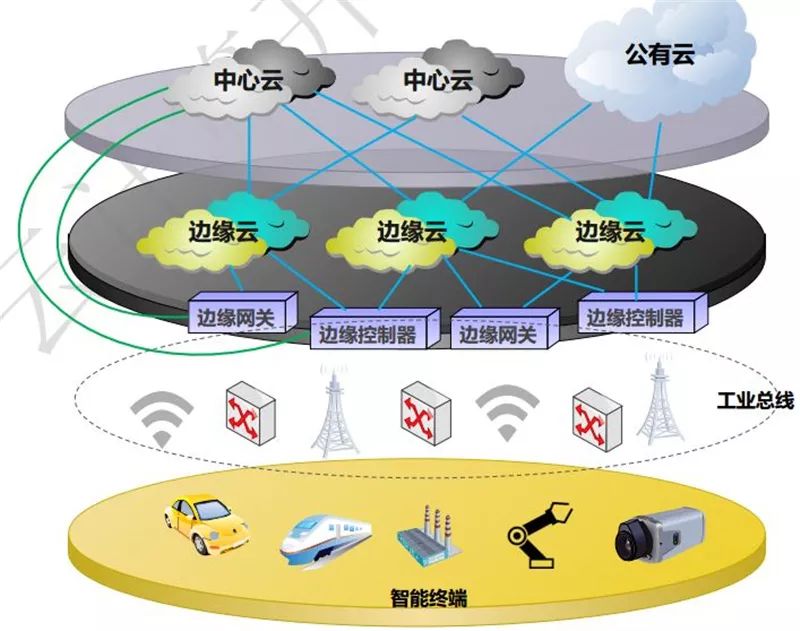 ▲ Cloud-Edge Collaboration Implementation in Industrial Internet
▲ Cloud-Edge Collaboration Implementation in Industrial Internet
3. Application of Cloud-Edge Collaboration in Energy Scenarios
The energy internet is a new form of energy industry development that deeply integrates the internet with energy production, transmission, storage, consumption, and energy markets, characterized by intelligent devices, multi-energy collaboration, information stacking, decentralized supply and demand, flat systems, and open transactions.
In the process of upgrading from traditional energy industries to energy internet, leveraging the advantages of both cloud computing and edge computing can accelerate the upgrading process.
Taking the oil industry as an example, a large amount of production data is generated at each key link of oil and gas extraction, transportation, and storage. In the traditional model, a significant amount of manpower is needed to periodically collect data through manual metering and monitor equipment to prevent safety accidents. Meter readers periodically report the collected data, which is then manually entered and analyzed by data personnel. This approach is not only costly but also inefficient in data analysis, resulting in high latency and an inability to grasp the status of key devices in real-time, making it impossible to foresee safety events and prevent accidents. The addition of edge computing nodes can achieve real-time automated data collection and safety monitoring of key equipment in oil and gas extraction through temperature, humidity, pressure sensor chips, and connected cameras. The raw data collected in real-time is first aggregated to the edge computing nodes for preliminary computational analysis, monitoring the health status of specific devices and controlling them as necessary. At this point, the data that needs to interact with the cloud is only the high-value data that has been processed and analyzed, which greatly saves network bandwidth resources and also provides data preprocessing services for subsequent big data analysis and data mining in the cloud, thus avoiding the multi-source heterogeneous data issues brought by various collection devices.
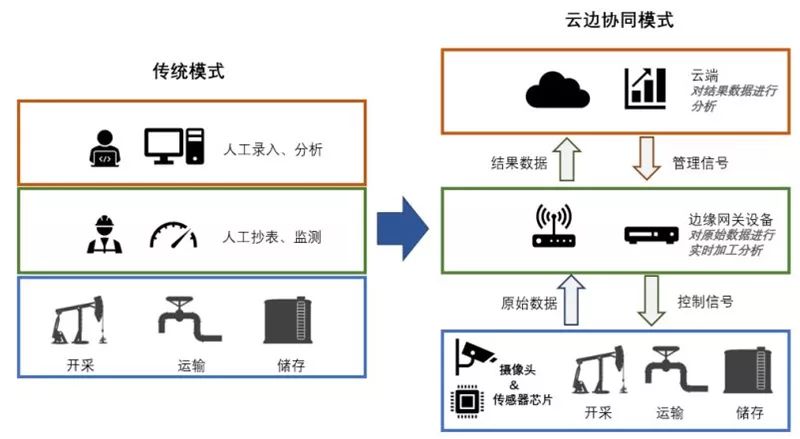 ▲ Application of Cloud-Edge Collaboration in the Oil Industry
▲ Application of Cloud-Edge Collaboration in the Oil Industry
In cloud-edge collaboration, terminal devices or sensors must possess certain computing capabilities to perform real-time processing of collected data, conduct local optimization control, automatic fault handling, load identification, and modeling operations, interacting the high-value processed data with the cloud, where the cloud conducts network-wide security and risk analysis, big data and AI pattern recognition, energy-saving, and strategy improvement operations. Additionally, if there are areas where network coverage is lacking, data can first be processed on the edge side and uploaded to the cloud when the network is available, where the cloud will conduct data storage and analysis.
4. Application of Cloud-Edge Collaboration in Smart Home Scenarios
With the gradual development of information technology, the continuous improvement of network technology, the increasing richness of applicable network carriers, and the gradual promotion of high-bandwidth indoor network strategies, intelligent information services entering homes have become possible. Smart homes comprehensively utilize internet technology, computer technology, remote control technology, etc., effectively combining home local networks, control of household devices, and information exchange among family members to create a comfortable, convenient, secure, and efficient modern home life.
In today’s smart home scenario, how various heterogeneous home devices can simply connect to the smart home network and how users can conveniently use the various functions within smart homes have become focal points.
In smart home scenarios, edge computing nodes (home gateways, smart terminals) possess various heterogeneous interfaces, including wired, powerline, coaxial cable, wireless, etc., and can process a large amount of heterogeneous data before uniformly uploading the processed data to the cloud platform. Users can not only connect to edge computing nodes through the network to control home terminals but can also access long-term data through the cloud.
At the same time, smart home cloud-edge collaboration is based on a virtualized technology cloud service infrastructure, utilizing diverse home terminals as carriers, integrating existing business systems, and utilizing edge computing nodes to form a home local area network consisting of household appliances, lighting control, multimedia terminals, computers, etc. Edge computing nodes then connect to the wide area network through the internet (in the future, also through 5G mobile networks) for data interaction with the cloud, thus enabling functions such as appliance control, security protection, video monitoring, timed control, environmental detection, scenario control, and visual intercom.
In the future, cloud-edge collaboration in smart home scenarios will receive increasing attention from all parties in the industry chain, with telecom operators, home appliance manufacturers, smart terminal manufacturers, etc., exploring in their respective fields. In the near future, the smart home information service industry will not only be limited to controlling household devices, but also closely integrating household energy, household healthcare, household security, and household education with smart home applications, becoming an integral part of the smart home family.
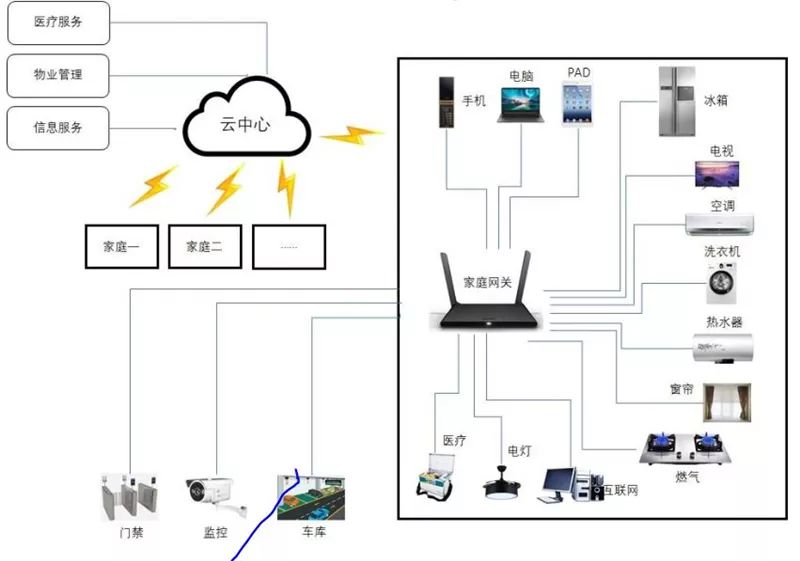 ▲ Diagram of Cloud-Edge Collaboration in Smart Home Informationization
▲ Diagram of Cloud-Edge Collaboration in Smart Home Informationization
5. Application of Cloud-Edge Collaboration in Smart Transportation Scenarios
Vehicle-road collaboration is an important development direction for smart transportation. The vehicle-road collaboration system employs advanced wireless communication and next-generation internet technologies to comprehensively implement real-time information exchange between vehicles and between vehicles and roads, and based on the dynamic collection and integration of traffic information across all times and spaces, carry out proactive safety control for vehicles and collaborative management of roads, fully realizing effective collaboration among people, vehicles, and roads to ensure traffic safety and improve passage efficiency, thus forming a safe, efficient, and environmentally friendly road traffic system. According to statistics from the Ministry of Public Security, as of the end of 2018, the number of cars in China exceeded 240 million, with 369 million drivers. It can be anticipated that vehicle-road collaboration has enormous market potential in China, providing a unique “testing ground” for the development and implementation of smart transportation in the country.
In the past, the focus of various parties on smart transportation was mainly on vehicles, such as autonomous driving, with R&D investments primarily in vehicle intelligence, which places high demands on the perception and computing capabilities of vehicles, resulting in high costs for smart cars. On the other hand, under current technological conditions, the performance of autonomous vehicles in traditional road environments is still unsatisfactory. Major manufacturers at home and abroad have gradually realized that roadside intelligence is indispensable for achieving smart transportation, leading them to invest in roadside intelligence over the past two years, aiming to achieve efficient interconnectivity and information sharing among people, vehicles, and roads.
In practical applications, edge computing can work in conjunction with cloud computing, integrating most of the computational load into the roadside edge layer, and utilizing 5G, LTE-V, and other communication methods for real-time information exchange with vehicles. Future roadside edge nodes will also integrate local map systems, traffic signal information, nearby mobile target information, and various sensor interfaces to provide vehicles with collaborative decision-making, accident warnings, and various services such as assisted driving. Meanwhile, vehicles themselves will also become edge computing nodes, working with cloud-edge collaboration to provide control and other value-added services.
Vehicles will integrate sensors such as lidar and cameras, exchanging collected data with roadside edge nodes and surrounding vehicles to expand perception capabilities and achieve collaboration between vehicles and between vehicles and roads. The cloud computing center will be responsible for collecting data from widely distributed edge nodes, perceiving the operational status of the traffic system, and issuing reasonable scheduling instructions to edge nodes, traffic signal systems, and vehicles through big data and AI algorithms, thereby improving the operational efficiency of the traffic system and minimizing road congestion.
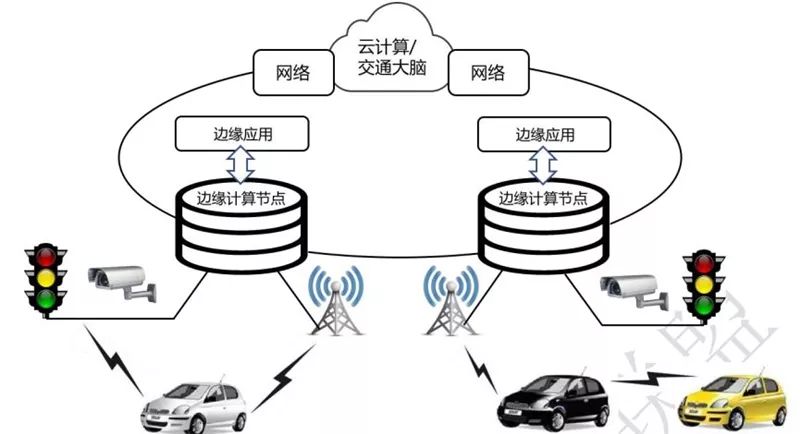 ▲ Reference Framework for Cloud-Edge Collaboration and Vehicle-Road Collaboration
▲ Reference Framework for Cloud-Edge Collaboration and Vehicle-Road Collaboration
6. Application of Cloud-Edge Collaboration in Security Monitoring Scenarios
Currently, in the field of security monitoring, traditional monitoring deployments generally adopt wired methods, covering all cameras with wired networks, which incurs high costs, low efficiency, and occupies a large amount of wired resources. Using WiFi for backhaul has poor stability and limited coverage, requiring a large number of additional routing nodes to ensure coverage and stability. In traditional methods, monitoring videos need to be transmitted to the cloud or servers for storage and processing through the backbone network and core network, which not only increases the network load but also makes it difficult to ensure effective end-to-end latency for services.
At the same time, many camera acquisition terminals are equipped with strong data acquisition capabilities, which raises high demands on the overall architecture of cameras, posing an important question of how to ensure processing capability and convenient installation while keeping the size fixed and power consumption low, while also ensuring that the cost of camera acquisition terminals remains low.
Based on the above demands, monitoring data can be offloaded to edge computing nodes (edge computing service platforms), effectively reducing network transmission pressure and end-to-end latency for services. In addition, video monitoring can also be combined with artificial intelligence, equipping edge computing nodes with AI video analysis modules for intelligent security, video monitoring, facial recognition, and other business scenarios, compensating for the high latency and poor user experience currently present in AI-based video analysis with low latency, high bandwidth, and quick response characteristics, achieving local analysis, quick processing, and real-time response. The cloud executes AI training tasks, while edge computing nodes perform AI inference, and the two work together to achieve local decision-making and real-time response, enabling various typical local AI applications such as expression recognition, behavior detection, trajectory tracking, hotspot management, and posture attribute recognition.
 ▲ Diagram of Cloud-Edge Collaboration Application in Intelligent Security Systems
▲ Diagram of Cloud-Edge Collaboration Application in Intelligent Security Systems
7. Application of Cloud-Edge Collaboration in Agricultural Production Scenarios
Smart agriculture is an advanced stage of agricultural production, integrating emerging technologies such as the internet, mobile internet, cloud computing, and IoT to achieve intelligent perception, intelligent warning, intelligent decision-making, and intelligent analysis of agricultural production environments through various sensor nodes deployed in agricultural production sites and wireless communication networks, providing precise planting, visual management, and intelligent decision-making.
Taking smart greenhouses as an example: for well-conditioned greenhouses, equipped with electric curtains, exhaust fans, automatic irrigation systems, and other electromechanical equipment, remote control functions can be achieved through the cloud. Farmers can log into the cloud system through their mobile phones or computers to control the switches of water valves, exhaust fans, and curtain machines in the greenhouse; they can also set control logic on the cloud, which will then be delegated to edge control devices, and edge control devices will collect real-time data on the greenhouse environment such as air temperature, humidity, carbon dioxide, light, soil moisture, soil temperature, outdoor temperature, and wind speed, automatically turning on or off the curtain machines, water valves, exhaust fans, and other electromechanical devices based on internal and external conditions.
 ▲ Diagram of Cloud-Edge Collaboration Application in Smart Greenhouses
▲ Diagram of Cloud-Edge Collaboration Application in Smart Greenhouses
8. Analysis of Cloud-Edge Collaboration in Cloud Gaming Scenarios
With the development of the internet and the reality of 5G networks today, the term “cloud gaming” is increasingly being utilized by more manufacturers and anticipated by more players. “Cloud gaming” refers to all games running on cloud servers, with the cloud compressing the rendered game images and transmitting them to users over the network for their terminals. Users’ gaming devices do not require any high-end processors or graphics cards, only basic video decompression and command forwarding capabilities.
In 2018, telecom giants such as AT&T and Verizon, as well as IT giants like Microsoft and Amazon, successively announced tests or layouts related to cloud gaming. At the 2019 MWC, domestic mobile manufacturers OPPO and OnePlus also demonstrated related cloud gaming services. According to forecasts from third-party organizations, the global cloud gaming market is expected to grow from $66 million in 2018 to $450 million in 2023, with a compound annual growth rate of 47%.
For example, in AR applications, applications need to determine the user’s location and direction based on camera views, positioning technology, or a combination of both. After analyzing location and direction information, the application can provide real-time information to the user. When the user moves, this information needs to be refreshed. Edge computing can offload computational tasks to edge servers or mobile devices, reducing average processing latency. The foreground interaction is placed in the cloud, while the background is handled by the mobile device, ultimately achieving a complete AR experience.
 ▲ Framework of Cloud-Edge Collaboration Application in Cloud Gaming
▲ Framework of Cloud-Edge Collaboration Application in Cloud Gaming
Smart Insights believes that there is a notion that edge computing is the opposite of cloud computing, which is actually incorrect. Edge computing is more of a new solution formed by extending cloud computing to the endpoint and user side. Edge computing is itself an extension of the cloud computing concept; even if it is given an independent concept, it cannot be completely severed from cloud computing, as both are interdependent and operate in synergy. Cloud-edge collaboration will become the mainstream model, and under this collaborative model, cloud computing is evolving towards a new form of more globalized distributed node combinations.
Upcoming Smart Insights Public Course
On July 10th at 7 PM, the 23rd lecture of the Super Public Course featuring NVIDIA will begin, with the theme “Application of Open Source GPU Data Science Platform RAPIDS in Financial Risk Assessment”. Scan the code for free reservation!

